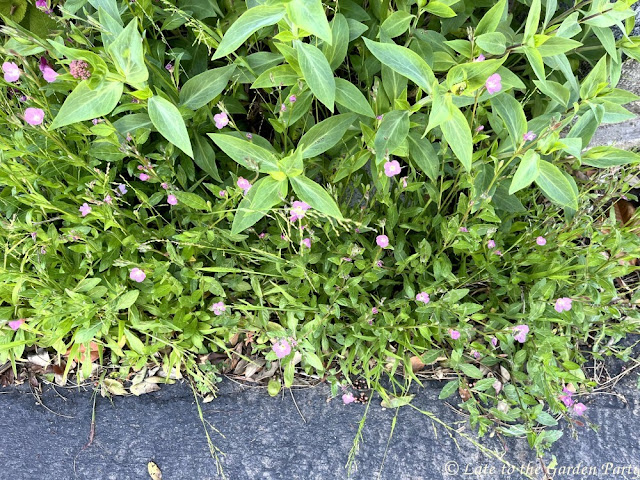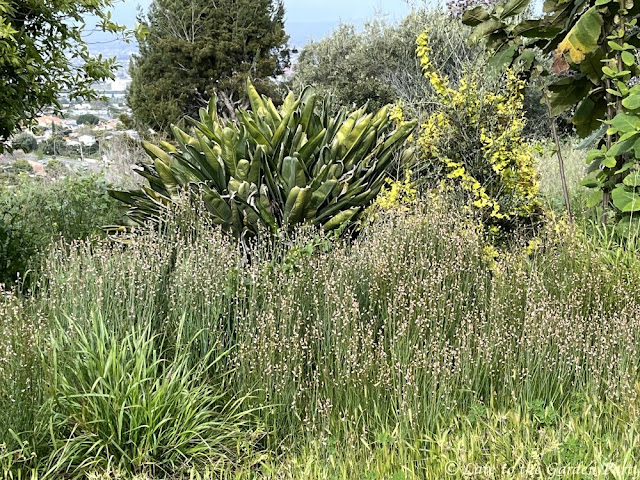As the saying goes, "April showers bring May flowers" but rain in general is guaranteed to deliver weeds. Some are pretty wildflowers that have simply gotten a bad rap due to their assertive behavior. Others are bona fide weeds, although it's surprising how often - if you dig deep enough - they have positive attributes you may at least want to recognize as you yank them out and dump them in your green waste bin.
I'm taking advantage of a meme inaugurated by Cathy of Words and Herbs this week to share three different weeds, one that isn't currently in my garden but seems to be moving its way throughout my neighborhood, creeping ever closer, and two others that are well-established in my garden and probably much of the surrounding area.
The first weedy wildflower is Asphodelus fistulosus, commonly known as onionweed. It's native to the Mediterranean area but it's become an invasive weed in the US, especially in California, Arizona, New Mexico, and Texas. It reportedly entered the US as an ornamental plant and spread uncontrollably through prolific self-seeding. I see it in untended areas along the street in my neighborhood, although I've yet to see it pop up in my own garden.
 |
| They remain prevalent in this homeowner's front garden, as well as many others. |
 |
| The flowers are attractive when viewed close up. However, all those black seeds will drop and produce more plants. The fibrous roots, if cooked, can be eaten as vegetables, or so I've read. The seeds can also be used as a diuretic and reportedly as a topical treatment to treat ulcers and inflammation (source). |
The second weed is prevalent on my back slope. Its foliage reminded me of certain Geraniums but it was very different from the Geranium incanum I featured in a Wild and Weedy post last year. My mobile phone's plant identification application identified this one as Geranium pusillum, commonly known as small-flowered geranium, a descriptive tag lacking in imagination. It's a herbaceous annual native to Europe but now often found in disturbed sites throughout North America.
 |
| It's the plant shown growing up through a patch of lamb's ear here |
 |
| The flowers should be described as tiny rather than "small". Ignoring the white alyssum (Lobularia maritima, also a weed here), can you make out the Geranium's pinky-purple flowers? |
 |
| This closeup of the flower was the best I could manage. Geranium pusillum has been used medicinally as a pain killer, an astringent to treat abrasions, and as a treatment for wounds. |
The last weed is Oenothera speciosa, also known as pink evening primrose, which I included in a post last year. This is probably the best known of the three weeds. It's a pretty wildflower but its prolific nature has many gardeners pulling it out at first sight. So far, in my garden, it's present on the back slope and my dry north-side garden, although I've seen evidence that it'd spread further if I was less vigilant. Mine haven't flowered yet but I've seen seedlings in both of the areas I mentioned getting ready to do so.
 |
| This wider shot shows the size of the tiny flowers growing in the neighbor's front border relative to the foliage of Centranthus ruber |
All material © 2012-2024 by Kris Peterson for Late to the Garden Party




This is a timely post. I think of the 3, I only get the geranium type. It would be interesting to see what pops up in different areas. My worst this year has been boring ol' grass. Lots of it.
ReplyDeleteOh, I have LOTS of the blanket-y blank grass weeds, Tracy! They're especially thick at the bottom of my back slope along the property line where the soil is more clay than sand - every time I think I've made a dent in them, they seem to reappear the moment I turn my back.
DeleteIf I had a large, wildflower meadow garden, all those pretty weeds would be welcome. I also think of how we alway search for the unusual, hard-to-get plants, when there are all those perfectly climate adapted 'common' plants everywhere... I'm guilty of this as well, I admit.
ReplyDeleteThe most adorable of the three you featured is Geranium incanum: I'm looking at your photos, ignoring the 'weedy' designation and just admiring how lovely it looks with the white alyssum and lamb ears. Quite a perfect vignette I'd say.
Chavli
I've considered leaving the Geranium pusillum plants in place, although those flowers are almost impossible to see without a magnifying glass. Geranium incanum has more impressive flowers and I understand it's sold in some garden centers but it has an annoying habit of popping up (everywhere) in the middle of other plants and it's almost impossible to pull it out with its roots intact.
DeleteThese are all new to me. My weed enemies are Cardamine hirsuta, aka hairy bittercress or shot weed and the tiny purple oxalis with yellow flowers. I recently noticed my next door neighbor had let an entire patch of shot weed go to seed. Ugh. Good luck with your eradication efforts!
ReplyDeleteI've got a lot of Oxalis weeds as well. However, this year, it's the marsh parsley (Cyclospermum leptophyllum) I featured in my March 14 post that's making me really miserable, mainly because its very difficult to remove its deep tap roots.
DeleteI'm intrigued by that miniature Oenothera, Kris, but I have no idea about it. Please let us know if you find out! I tend to be wary of most Oenotheras as I've had my share of difficulties with O. speciosa. I do, however want to take a chance with O. pallida here. And of course, Gaura is now considered a member of the genus! My weed of the moment is fiddleneck (Amsinckia prob. tessellata) which has all gone to seed in the areas where I wasn't able to clear it out... grrrr... It's toxic to livestock, but my horses try to eat it whenever I walk them near it, so I'm doubly miffed about its presence and not looking for any good qualities, though it probably has some!
ReplyDeleteWell, in practical terms a weed is anything that grows where you don't want it and we all have those. Now that you mention it, I believe I heard that Gaura is now classified as Oenothera - it has a nasty tendency to move itself around too.
DeleteHave seen maybe the last one, not the others around here.
ReplyDeletePennisetum setaceum has quickly become a bad weed around here and it's a real wildfire menace--multiplying the problem.
San Marcos Growers makes a distinction between Pennisetum x advena 'Rubrum' and Pennisetum setaceum, although it appears that the 2 are often sold as one in the same thing. SMG also maintains that the cultivar 'Fireworks' is a hybrid as well and argue that the P. advena hybrids don't commonly spread or post the same risk as P. setaceum.
DeleteSo true--your last statement about weeds. It's too bad that so many of them are beautiful and interesting but invasive...especially the ones that take over our gardens. Thanks for sharing the history on the Onionweed, and the Geranium sure has a pretty flower. Darn.
ReplyDeleteThe Geranium's flower is pretty when blown up in size, Beth, but I'm guessing you wouldn't even notice it unless you were down on the ground with a magnifying glass. Not much of a loss, although I think the foliage is fairly attractive.
DeleteWe have that little Geranium everywhere Kris! In fact itbis on my list to cover this year. I am not familiar with the first plant. The pink evening primrose is sold here as a perennial but I have never noticed it in the wild so it hasn't spread here yet. We only have the tall native yellow evening primrose. (Also on my list to cover this year!) Hopefully I can start up the weekly meme again soon, now it has warmed up. As always, very interesting to see what grows wild in your area!
ReplyDeleteI look forward to your wild and weedy posts, Cathy! One can always depend on weeds to show up ;)
DeleteHmm, I think I just planted some seeds of Oenothera speciosum out in the seedframe earlier this year. I may need to rethink that.
ReplyDeleteYour winter weather conditions might keep the Oenothera in check, Jerry. The flowers are pretty. Fingers crossed!
Delete